Digital Switching: Raymarine, Empirbus, Simrad, Naviops, Offshore, Octoplex, Garmin and CZone
Digital switching is one of the most intriguing aspects of modern marine electronics, but also one of the most mysterious. At FLIBS, for instance, I wasn’t the only boater jealously admiring sexy screens like the one above running on a Raymarine gS15 multifunction display. But when you try figuring out how you can get this elegant level of system control and monitoring onto your boat, you’ll eventually realize that there is a complex conglomeration of hardware and software behind it, and it’s usually under marketed and lightly documented. In fact, the whole concept still mainly makes sense for new and higher end boats, because it’s an expensive and entirely different way of doing things, and those builders remain understandably cautious about adopting it. Nonetheless — and another sign of a re-invigorated recreational marine industry — I detected lots of digital switching progress at the fall shows…
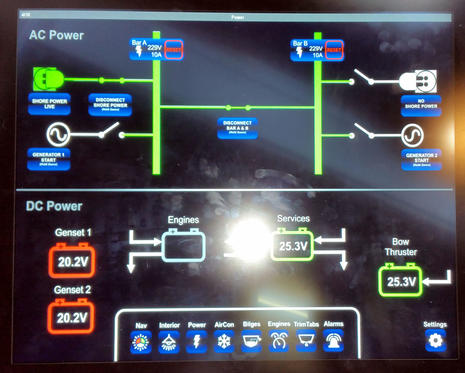 Raymarine seemed to show even more elaborate MFD digital switching screens at METS, and rumor has it that such features are becoming standard on certain Azimut and Sea Ray models. But don’t expect to see specifics about digital switching systems on the websites of those builders; they seem especially reluctant to call out separate brand subsystems like these, preferring to let them look like the custom integrations they largely are. (This Azimut Technical School page is revealing, however). At any rate, lack of publicity is one reason why I hope you’ll tolerate my poor boatshow photos – fingerprints and glare included.
Raymarine seemed to show even more elaborate MFD digital switching screens at METS, and rumor has it that such features are becoming standard on certain Azimut and Sea Ray models. But don’t expect to see specifics about digital switching systems on the websites of those builders; they seem especially reluctant to call out separate brand subsystems like these, preferring to let them look like the custom integrations they largely are. (This Azimut Technical School page is revealing, however). At any rate, lack of publicity is one reason why I hope you’ll tolerate my poor boatshow photos – fingerprints and glare included.
This is a good time to note that digital switching almost invariably includes microprocessor-based circuit protection and monitoring. The results are a significant reduction in wiring, often called distributed power, and the ability of the system to sense the electrical currents passing through it. In other words, the switching seen on the screens above is not just the fancy equivalent of an electromechanical button or toggle switch panel; when the nav light graphic icons illuminate with a screen touch, for instance, the system knows that they’re actually consuming a specific current at a specific voltage and can alarm you if otherwise.
 As described here in 2013, the primary module in Raymarine’s digital switching system has been the powerful EmpirBus NXT. But now Trigentic has developed the Connect 50 “for smaller and less complex installations.” The Connect still has 20 programmable DC output channels with niceties like built-in light dimming and advanced wiper controls, plus 11 input channels for mechanical (like) switching and analog sensors. Measuring and digitizing tank levels, voltages, pressures, etc. is another common feature of digital switching systems and, as you’ll see way below, EmpirBus is not the only brand adding flexible multi-channel I/O designs that should cost less and install easily in smaller boats.
As described here in 2013, the primary module in Raymarine’s digital switching system has been the powerful EmpirBus NXT. But now Trigentic has developed the Connect 50 “for smaller and less complex installations.” The Connect still has 20 programmable DC output channels with niceties like built-in light dimming and advanced wiper controls, plus 11 input channels for mechanical (like) switching and analog sensors. Measuring and digitizing tank levels, voltages, pressures, etc. is another common feature of digital switching systems and, as you’ll see way below, EmpirBus is not the only brand adding flexible multi-channel I/O designs that should cost less and install easily in smaller boats.
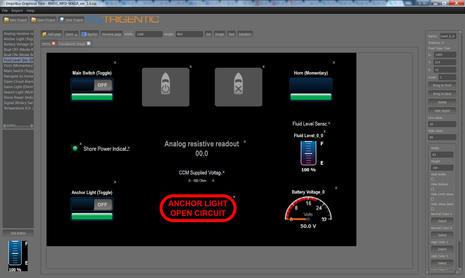 I was surprised to find EmpirBus Graphic software available for download on the Trigentic site, and it appears that a boat builder, electronics installer or end user can use it to build those lovely Raymarine digital switching screens. However, the EmpirBus Studio program used to actually configure the modules — and thus create the function file represented in the upper left window above — is not available. The process, as I understand it, is that Trigentics does the module programming in consultation with Raymarine and the client, and then Ray maintains an offboat copy as part of its global support for the system, which seems like a good thing.
I was surprised to find EmpirBus Graphic software available for download on the Trigentic site, and it appears that a boat builder, electronics installer or end user can use it to build those lovely Raymarine digital switching screens. However, the EmpirBus Studio program used to actually configure the modules — and thus create the function file represented in the upper left window above — is not available. The process, as I understand it, is that Trigentics does the module programming in consultation with Raymarine and the client, and then Ray maintains an offboat copy as part of its global support for the system, which seems like a good thing.
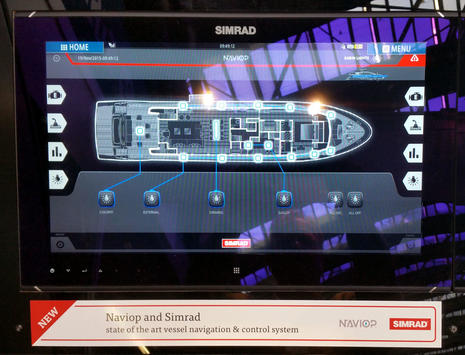 Simrad — which trailblazed digital switching on an MFD with CZone in 2010 — showed off a new partnership at METS. I was not familiar with Naviop Marine Automation, but it didn’t take much time in their booth (or on their website) to see that they are deep into the complex world of bigger boat system management. They offer their own nav/monitoring touchscreen displays, for instance, and the graphic interfaces are highly customizable. So the Simrad relationship is not so much global distributor as alternate interface screen provider. In fact, Simrad told me that it was relatively easy to create a Naviop server within NSS evo2 and they’re open to doing similar with other digital switching developers.
Simrad — which trailblazed digital switching on an MFD with CZone in 2010 — showed off a new partnership at METS. I was not familiar with Naviop Marine Automation, but it didn’t take much time in their booth (or on their website) to see that they are deep into the complex world of bigger boat system management. They offer their own nav/monitoring touchscreen displays, for instance, and the graphic interfaces are highly customizable. So the Simrad relationship is not so much global distributor as alternate interface screen provider. In fact, Simrad told me that it was relatively easy to create a Naviop server within NSS evo2 and they’re open to doing similar with other digital switching developers.
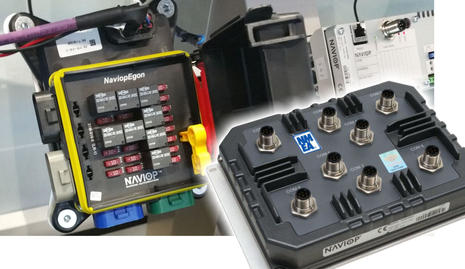 Note the large quiver of Naviops power distribution and data interface modules available, like the Egon, the Nova, and especially that wild T-Box N2000 sprouting Ethernet, N2K, multiple CanBus and RS232/422/485 ports. “More than 50 communication protocols implemented (engines, air conditioning, generators, battery chargers, entertainment systems, digital switching systems, etc.)” is the Naviops’ claim, and I was told that EmpirBus and CZone are included. In short, the sophisticated-seeming digital switching I’m most familiar with can be a subsystem of a bigger boat install, and all of it can now be seen and managed on Simrad helm displays.
Note the large quiver of Naviops power distribution and data interface modules available, like the Egon, the Nova, and especially that wild T-Box N2000 sprouting Ethernet, N2K, multiple CanBus and RS232/422/485 ports. “More than 50 communication protocols implemented (engines, air conditioning, generators, battery chargers, entertainment systems, digital switching systems, etc.)” is the Naviops’ claim, and I was told that EmpirBus and CZone are included. In short, the sophisticated-seeming digital switching I’m most familiar with can be a subsystem of a bigger boat install, and all of it can now be seen and managed on Simrad helm displays.
 Offshore Systems now has similar capabilities. While the company used to specialize in relatively simple though often unique NMEA 2000 sensors — like this cool fuel fill — at METS 2015 they were posing in the Superyacht Pavilion with their own BlackGlass Bridge Systems, touch screens and highly evolved control and monitoring software/hardware included. Managing Director Bruce Coward (at left) is very proud of the highly flexible screen design software they’ve developed, but before I get further into BlackGlass, let’s sidetrack to that Dual Engine Display, which we honored with an Innovation Award at IBEX 2014. Its beauty is not just how sleekly it can fit onto a modern helm — as seen in this Princess 68 sea trial video — but how it can completely display whatever is coming from the engines in J1939 or N2K format, replacing the clunkier gauge displays from most major engine manufacturers at significantly less cost and with no warranty issue! (Note to the trade: Coward allows that it was big engine customers like Princess that got the manufacturers to relent on the warranty issue, not his electronics company.)
Offshore Systems now has similar capabilities. While the company used to specialize in relatively simple though often unique NMEA 2000 sensors — like this cool fuel fill — at METS 2015 they were posing in the Superyacht Pavilion with their own BlackGlass Bridge Systems, touch screens and highly evolved control and monitoring software/hardware included. Managing Director Bruce Coward (at left) is very proud of the highly flexible screen design software they’ve developed, but before I get further into BlackGlass, let’s sidetrack to that Dual Engine Display, which we honored with an Innovation Award at IBEX 2014. Its beauty is not just how sleekly it can fit onto a modern helm — as seen in this Princess 68 sea trial video — but how it can completely display whatever is coming from the engines in J1939 or N2K format, replacing the clunkier gauge displays from most major engine manufacturers at significantly less cost and with no warranty issue! (Note to the trade: Coward allows that it was big engine customers like Princess that got the manufacturers to relent on the warranty issue, not his electronics company.)
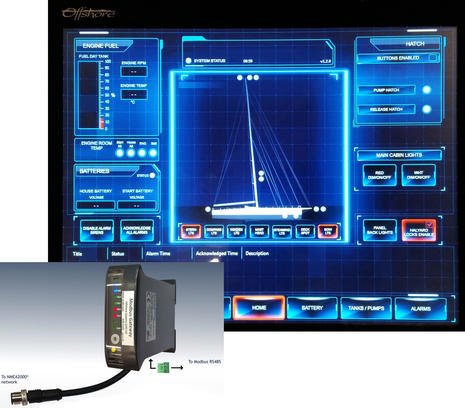 The home screen for the 88-foot sailing yacht above is just one of many BlackGlass interfaces you can check out online, but again you can see how digital switching has moved well beyond lighting and similar commonplace functions. Apparently you can lock off the boat’s halyard with this touch screen, for instance. One thing that’s going on here, and with Naviops too, is that N2K sensing and switching is becoming a component of the bigger do-anything PLC-based systems that are nearly “traditional” on very large yachts. Hence Offshore developed its NMEA 2000 to Modbus Gateway and added ABB Programmable Logic Controllers to their behind-the-scenes tool kit.
The home screen for the 88-foot sailing yacht above is just one of many BlackGlass interfaces you can check out online, but again you can see how digital switching has moved well beyond lighting and similar commonplace functions. Apparently you can lock off the boat’s halyard with this touch screen, for instance. One thing that’s going on here, and with Naviops too, is that N2K sensing and switching is becoming a component of the bigger do-anything PLC-based systems that are nearly “traditional” on very large yachts. Hence Offshore developed its NMEA 2000 to Modbus Gateway and added ABB Programmable Logic Controllers to their behind-the-scenes tool kit.
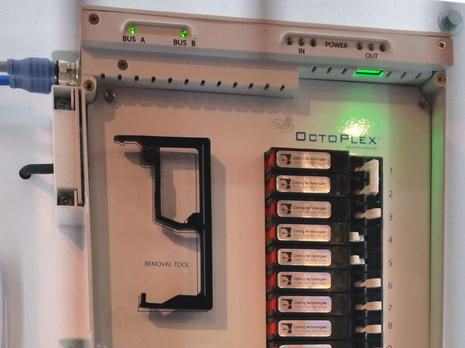 When it comes to bigger boat switching and distributed power, OctoPlex is still very much in the game, with Gen2 components coming online and the relationship with sibling brand Maretron deepening. (Maretron has its own basic digital switching, by the way.) Digitally managing AC switching and circuit protection remains one of the tough issues in this niche, because it still can’t be done solely with transistors, and (probably thanks to the Carling Technologies mothership) OctoPlex seems to offer exceptionally slick solenoid-activated AC breaker panels. Note the redundant N2K control cables, the included breaker removal tool, and the “all’s well” green LED that usually glows through the window on the panel’s (not shown) outer cover, but will go red if a breaker trips. The OctoPlex team at FLIBS was especially proud of the stellar uptime record their many Viking installs have accrued, evidenced by the fact that their system has been chosen again for the new 80 Series (great in-build PDF here).
When it comes to bigger boat switching and distributed power, OctoPlex is still very much in the game, with Gen2 components coming online and the relationship with sibling brand Maretron deepening. (Maretron has its own basic digital switching, by the way.) Digitally managing AC switching and circuit protection remains one of the tough issues in this niche, because it still can’t be done solely with transistors, and (probably thanks to the Carling Technologies mothership) OctoPlex seems to offer exceptionally slick solenoid-activated AC breaker panels. Note the redundant N2K control cables, the included breaker removal tool, and the “all’s well” green LED that usually glows through the window on the panel’s (not shown) outer cover, but will go red if a breaker trips. The OctoPlex team at FLIBS was especially proud of the stellar uptime record their many Viking installs have accrued, evidenced by the fact that their system has been chosen again for the new 80 Series (great in-build PDF here).
I’ll add that not all digital switching systems have accrued a good record, though the stories are very hard to document. Rumors abound of light switches that suddenly operated anchor winches, not to mention total system burnouts from nearby lightning strikes, plain old fires, and — perhaps the technology’s greatest setback — builders who had to replace entire bow-to-stern systems with the traditional power cabling they could have done for a small fraction of the cost in the first place. But those stories are mostly old, some of the purported culprits have shrunk or vanished, and there are getting to be a fair number of successful boats out there with digital switching.
 Integration with the big color touchscreen display systems that dominate many new boat helms these days is certainly part of how digital switching is succeeding, and Mastervolt CZone is seen as the current winner in this area, with relationships to both Garmin and the Navico brands. At FLIBS, I was pleased to see that Garmin now lets users modify CZone pages, though the underlying configuration remains at OEM level.
Integration with the big color touchscreen display systems that dominate many new boat helms these days is certainly part of how digital switching is succeeding, and Mastervolt CZone is seen as the current winner in this area, with relationships to both Garmin and the Navico brands. At FLIBS, I was pleased to see that Garmin now lets users modify CZone pages, though the underlying configuration remains at OEM level.
But the big CZone news is the new COI module seen below (though there’s nothing about it online yet). The COI will pack the capabilities of several existing CZone modules into one less expensive box that can conceivably control all the power needs and many of the sensor needs of a modest vessel. Note that all the labeling on the show demo below is for one specific boat configuration. The 14 power outputs can protect and switch most any circuits as long as the total amperage doesn’t exceed 150, and similarly the 8 analog and 6 digital inputs can do all sorts of tasks besides the ones listed. Meanwhile the IN-D port is for boats that don’t even use N2K interface and the USB port means that a CZone system with a COI can be programmed without a separate gateway. And remember that CZone seems more willing than most to deal with a retrofit and/or a lone dealer/installer (or sometimes even a DIY guy like me).
Mostly though, digital switching is going to be seen on new boats, and I believe it will make those boats more and more tempting.


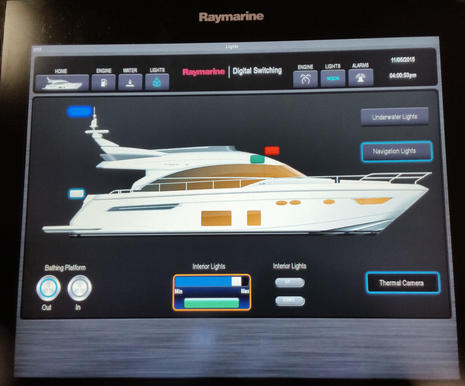
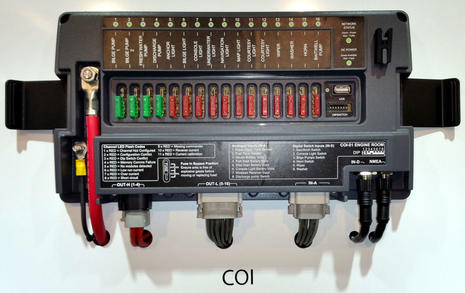
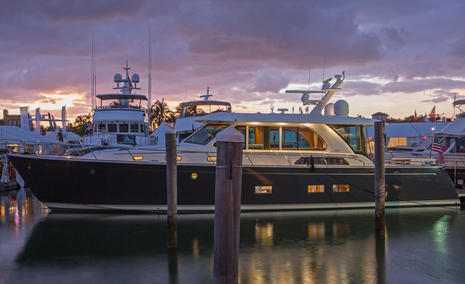

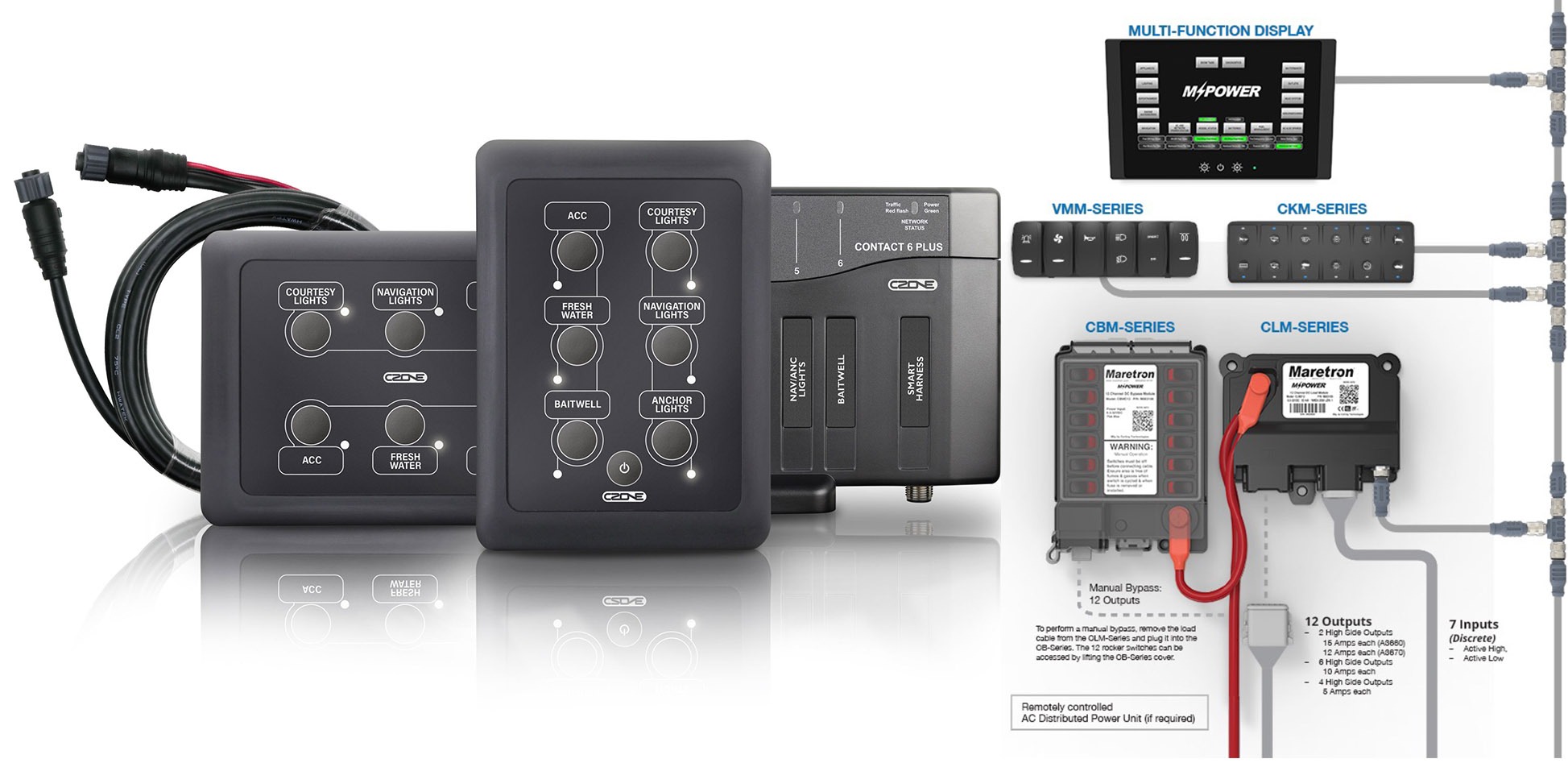








Hi Ben, great overview of the tech all in one place. I like digital switching, but I also spent a year dealing with one of the more substantial horror stories. So I have some caveats when I talk to customers about it. You touched on documentation, or perhaps the lack of it, but it’s critical that there be excellent documentation, and in my personal opinion a copy of the all of docs, wiring diagrams, and the software should be delivered with the boat.
It should also be clear who owns the software, and what access an owner has to it. I was involved in a unfortunate struggle with a company over a boat’s software. They claimed they owned it, but no longer had the capability or personnel to support it, and had largely lost control of the many versions. We painfully prevailed and had to hire a third party to help correct problems with the system.
Redundancy is very important. There needs to be manual and directly switched overrides, ahem, in convenient locations for critical vessel functions.
Buyers should carefully consider the technical lifespan of this equipment. It’s often very custom and built by smaller companies. If the company that built the gear is no longer for what ever reason able to continue support and supply parts where does that leave the owner?
Mortiz’s digital switching systems are a early classic example of what happens when a company goes away, and any breaker on a 1973 Hat Yachtfish can still be inexpensively replaced. No I’m not a Luddite. I’ve just been bit, more than once.
Ben, I’m going to offer a hearty “AMEN” to Bill’s comment – the system software in the various devices and controllers needs to be (IMHO) an order of magnitude more robust before I’m going to trust it with load switching on any boat of mine.
An example of why I’m disenchanted: I put brand new Raymarine on Atsa back in the summer of 2013 – new chartplotter, AIS, radar and autopilot, plus the interface to my older Ray speed/wind/depth system. I have had a number of issues, pretty much linked to two issues: unexpected digital silliness and incompatible firmware versions. My S-H GX1600 DSC radio turned out to be echoing back everything the chartplotter sent to it via NMEA-0183 – which caused the e95 to become essentially disabled. Not really Raymarine’s fault, but I would expect the firmware to be more robust than that (and I still can’t turn on the radio until the e95’s GPS is fully up & running!). Don’t even get me started on the blizzard of sometimes-incompatible firmware versions for the various newer Raymarine pieces of my system. At the time, the helpful folks at the Ray Tech forum helped me resolve the issues – but based on my recent (rather rude) experience with them, I no longer expect much help from that source.
Sorry, but I don’t want a system that is this touchy & difficult to service being the only way I can turn on & off my lights, pumps and other essential systems!
Good points, Bill, but I do think that some of the weaker hands have already folded. I’m confused by your reference to Moritz, however.
Carling Technologies bought Moritz Aerospace and its infant OctoPlex system way back in 2004. They eventually dropped the Moritz branding (and sold off the aviation portion, I think) but OctoPlex is alive and well. So are you mistaken or did I miss something?
Thanks again for the info Ben !
A lot of goodies and things to play with, I can’t afford most of them but it’s fun trying to figure out a cheaper way 😉
Having said that, I agree with the writers above in relation to reliability. I’m retired now but spent my civilian career as proces control- and automation trouble shooter. Old enough to see the first discreet semiconductors appear and long enough to experience full integration. So by nature I wonder what might go wrong with a system or in some cases what WILL go wrong with a system.
I recommend a common-sense approach with fancy stuff: be sure to have a solid and good working foundation before you add a latest fashion MFD to turn a simple pump on or off. That latest fashion might fail on you and the simple pump might turn out to be a life-saver.
And yes, I do have my little boat crammed full with electronics, comms, radar etc. etc. Just for the fun of it 😉 But my basic systems are hard-wired controlled with good quality fuses, connections, cables and switches. This investment delayed the installation of the fun bits but it provides the best level of reliabilty I can afford.
w fr greetings, Leo
Ben, your right, between Darwin culling the herd, and lessons learned the quality, and durability of these systems have improved orders of magnitude. The Carling Moritz thing was more complicated and a bit of a cautionary tale. Carling did acquire Moritz (2006ish I think), but more than just rebranding, they redesigned the system, and then discontinued the old product line shortly afterwards. This left the original owners with no support. I bought the very last control box in 2010 from a builder’s inventory after days of searching.
The problem with these systems is if the manufacturer goes out of business (remember the Eplex scare) without really excellent documentation on the why, how, where, and what it was doing it will be be extremely difficult and expensive to retrofit another extensive system to replace it. It’s not a hardware thing with me as much as the lack of documentation that comes with it, the installation and user access to the software. This is why I harp so much about this shortcoming.
We are a big supporter of CZone and have been since its creation. Fair to say it had its teething problems, but now 8 years on it is a robust and ever evolving solution backed up by great global support.
We look forward to the COI and other product releases in 2016 that will help us engineer better solutions for our customers
Good Afternoon Ben,
I have ordered a new build Seawind 1190 Sport and am deciding wether to take the CZone option. On one hand, it seems great, but I worry that I may regret it in some remote location when nobody can fix it. It is also $7200, but would be worth it if if works.
Hi Maldwin,
I think that CZone is a stable and well-supported system at this point, plus it includes a simple blade fuse workaround so you can manually switch any circuit if the “brains” get wacky. But I’ve rarely heard of anyone using them. Two notes, though:
I’d want to know if Seawind has installed many CZone systems. Sabre, for instance, started out with small systems before going whole hog, and they are carefully designed.
At METS this week, CZone and Mastervolt are introducing several new products and redesigned current products that apparently make the integration of both even better and likely have other features. I’ll know more soon, but it does seem possible that your build timeline allows for the these?
PS Looks like a cool cat. I got to sail up Penobscot Bay at 12+ knots on the somewhat similar Maine Cat 37 last week, and it was great despite snow and rain. (But then had to be towed into Front Street because the electric propulsion system has yet to be completely sorted out, long story.)
Thank you very much Ben. I gave serious thought to the MC38, but it didn’t have quite enough elbow room, and I was a little worried about the dependability of the power plant.